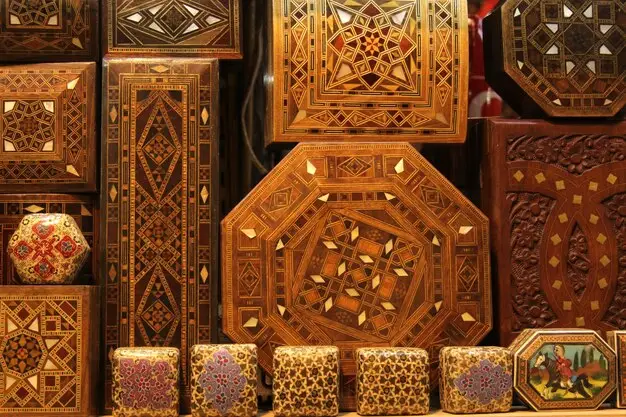Introduction: Unlocking the Artistic Potential of Thuya Burl
In the realm of woodworking, few materials possess the allure and mystique of Thuya burl. This exotic wood, sourced primarily from the Atlas Mountains of North Africa, is celebrated for its rich grain patterns and aromatic fragrance. When paired with the ancient crafts of wood carving and inlay, Thuya burl transcends its humble origins to become a canvas for unparalleled artistic expression. In this article, we embark on a journey to explore the enchanting world of wood carving and inlay, and how they converge to transform Thuya burl into exquisite works of art.
Unveiling Thuya Burl: A Natural Wonder
The Origin of Thuya Burl
Thuya burl, also known as Moroccan Thuja or Amazigh Thuya, originates from the burl growths of the Tetraclinis articulata tree, native to the Atlas Mountains of Morocco. These burls, prized for their unique appearance and durability, are harvested sustainably by local artisans who have honed their techniques over centuries.
Characteristics of Thuya Burl Wood
Thuya burl wood is renowned for its distinctive grain patterns, which range from swirling whirls to intricate mosaics. Its color palette spans from warm golden hues to deep chocolate browns, adding to its visual appeal. Moreover, Thuya burl emits a delightful fragrance reminiscent of cedar, making it a popular choice for decorative pieces and aromatic accents in interiors.
Mastering the Art of Wood Carving
Techniques and Tools of Wood Carving
Wood carving is a time-honored craft that involves shaping wood into intricate designs and sculptures using specialized tools such as chisels, gouges, and mallets. Among the various techniques employed by wood carvers are relief carving, carving in the round, and chip carving, each requiring precision and skill to execute.
Historical Significance of Wood Carving
Throughout history, wood carving has played a significant role in both artistic expression and functional craftsmanship. From ornate furniture and architectural embellishments to religious artifacts and ceremonial objects, wood carvings have adorned civilizations across the globe, serving as testaments to human creativity and ingenuity.
The Enchantment of Wood Inlay
Types of Wood Inlay Techniques
Wood inlay, also known as marquetry or intarsia, involves the insertion of contrasting wood or other materials into a base wood to create decorative patterns or images. Common techniques include piece-by-piece inlay, where individual segments are fitted together like a puzzle, and sand shading, which adds depth and dimension to the design.
Application and Importance of Wood Inlay in Art
Wood inlay has been employed in various artistic disciplines, including furniture making, cabinetry, and musical instrument construction. Beyond its aesthetic appeal, inlay serves practical purposes such as reinforcing joints, adding structural stability, and highlighting specific features of a piece, elevating it from ordinary to extraordinary.
Thuya Burl Art: Where Wood Carving Meets Inlay
Fusion of Woodworking Techniques
Thuya burl art represents the harmonious convergence of wood carving and inlay, blending the intricate detail of carving with the decorative flourish of inlay. Artisans skilled in both disciplines leverage the natural beauty of Thuya burl to create mesmerizing compositions that captivate the eye and stir the soul.
Notable Thuya Burl Artisans and Their Work
From intricately carved jewelry boxes to elaborately inlaid furniture pieces, the work of Thuya burl artisans spans a diverse range of forms and functions. Renowned craftsmen such as Empire Thuya Furniture and Royal Thuya Boxes showcase the versatility and craftsmanship inherent in Thuya burl art, earning acclaim from collectors and connoisseurs worldwide.
Original Insights: Unlocking the Mysteries of Thuya Burl
Unique Properties of Thuya Burl Wood
Thuya burl wood possesses unique properties that set it apart from other hardwoods. Its tight grain structure and natural oils make it exceptionally resistant to decay and insect damage, ensuring longevity and durability in finished pieces. Additionally, the irregular growth patterns found in burls contribute to the wood’s character and visual appeal, making each piece truly one-of-a-kind.
Cultural and Symbolic Significance
In Moroccan culture, Thuya burl holds deep symbolic meaning, representing strength, resilience, and connection to the natural world. Traditionally used in the crafting of luxury items and sacred objects, Thuya burl is revered for its rarity and beauty, embodying the spirit of craftsmanship passed down through generations.
FAQ: Answering Your Burning Questions About Thuya Wood Carving and Inlay
- What are the essential tools for wood carving?
- Wood carving requires specialized tools such as chisels, gouges, mallets, and carving knives. These tools come in various shapes and sizes to accommodate different carving techniques and styles.
- What types of wood are commonly used for inlay?
- In addition to Thuya burl, popular woods for inlay include ebony, maple, rosewood, and walnut. Each wood species offers unique characteristics and aesthetics, allowing artisans to create diverse and visually striking designs.
- How do you prevent wood inlay from cracking or warping?
- Proper preparation and sealing of the base wood are essential to prevent cracking or warping of inlaid pieces. Additionally, maintaining consistent humidity levels in the surrounding environment helps minimize the risk of moisture-related damage.
- Can beginners learn wood carving and inlay techniques?
- Yes, beginners can learn wood carving and inlay techniques with dedication, practice, and guidance from experienced craftsmen or instructional resources. Starting with simple projects and gradually building skills is key to mastering these crafts.
- Where can I purchase Thuya burl art and products?
- Thuya burl art and products can be found online through artisanal marketplaces, specialty woodworking shops, and galleries specializing in handcrafted goods. Andalusian Thuya Vases and Wooden Thuya Sculptures are just a few examples of the exquisite offerings available for enthusiasts and collectors alike.
Conclusion: Celebrating the Timeless Beauty of Wood Carving and Inlay
In conclusion, wood carving and inlay represent enduring traditions that continue to captivate and inspire artisans and enthusiasts alike. Through the skilled manipulation of materials and techniques, craftsmen breathe life into humble pieces of wood, transforming them into works of art that transcend time and culture. Whether it’s the intricate detailing of a carved motif or the delicate precision of an inlaid pattern, the beauty of these crafts lies in their ability to evoke emotion and provoke wonder. As we celebrate the magic of wood carving and inlay, let us cherish the rich heritage and boundless creativity they embody, ensuring their legacy endures for generations to come.


